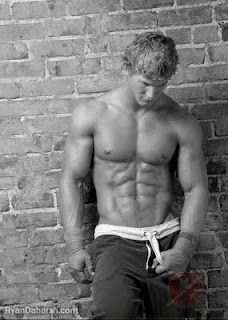from Gregory Woods's "Articulate Flesh: Male Homo-eroticism & modern poetry"
The book begins with a white-hot description of the male body. "Three types of male physiques, " writes Woods, "three distinct ideals, occur in Western art: the adolescent pliancy of Narcissus, Apollo's form but graceful maturity, and the potency of Heracles, tacitly poised on the verge of deterioration." He elaborates:
How perfect of the perfect to be the god of song!
The three physical types correspond with sexual types. The adolescent may be endowed with an indefatigable penis, but is chiefly admired for the delightful promise of his backside. Shakespeare is not interested in his boyfriend's penis (sonnet 20). . . .
Heracles is the opposite type, unequivocally phallic. When he lays down his club, he is still heavily armed. His musculature seems designed for the pinning down of loved ones, while the phallus does its work. He and the adolescent, as sexual opposites, together form the perfect couple: Heracles and Hylas, Hadrian and Antinous.
Between the two lies the adaptability of Apollo, the single couple: a dual sexual nature in one physique. He is best depicted in three dimensions: for we must be able to wander at will from penis to buttocks to penis, gazing at his statue as though in his bed, making love with each aspect of him in turn. He has no one point on which to focus, and must be sculpted or described as the body, complete. . . . In the versatility of his manhood, Apollo is, perhaps, the ideal ideal.
How perfect of the perfect to be the god of song!
Ryan Daharsh, model



Comments